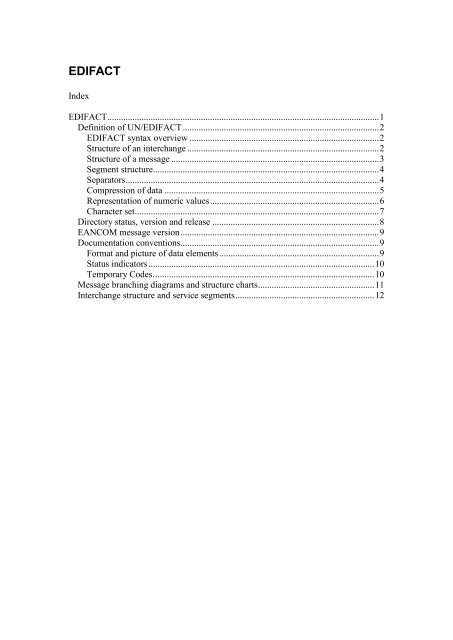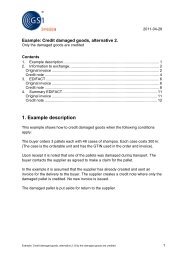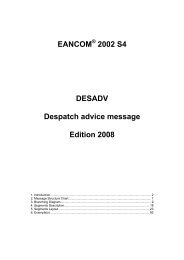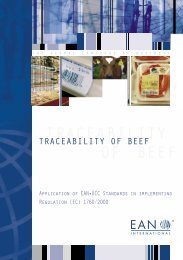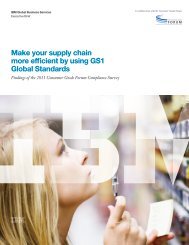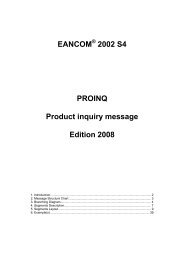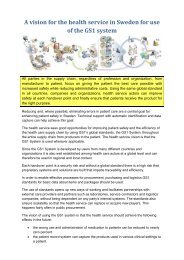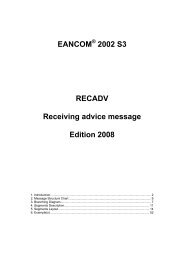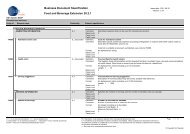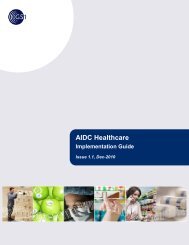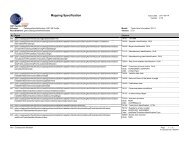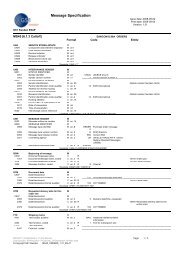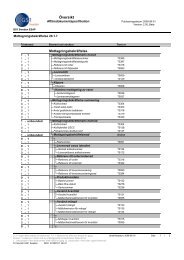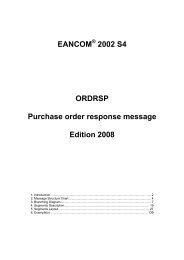Definition of UN/EDIFACT - GS1
Definition of UN/EDIFACT - GS1
Definition of UN/EDIFACT - GS1
You also want an ePaper? Increase the reach of your titles
YUMPU automatically turns print PDFs into web optimized ePapers that Google loves.
<strong>Definition</strong> <strong>of</strong> <strong>UN</strong>/<strong>EDIFACT</strong><strong>UN</strong>/<strong>EDIFACT</strong>: United Nations rules for Electronic Data Interchange for Administration,Commerce and Transport. They comprise a set <strong>of</strong> internationally agreed standards,directories and guidelines for the electronic interchange <strong>of</strong> structured data, and in particularthat related to trade in goods and services, between independent computerised informationsystems.Recommended within the framework <strong>of</strong> the United Nations, the rules are approved andpublished by the <strong>UN</strong>/ECE/WP.4 (United Nations / Economic Commission for Europe /Working Party 4) in the United Nations Trade Data Interchange Directory (<strong>UN</strong>TDID) and aremaintained under agreed procedures. <strong>UN</strong>TDID includes: <strong>EDIFACT</strong> syntax rules (ISO 9735); Message design guidelines; Syntax implementation guidelines; <strong>EDIFACT</strong> Data Elements Directory, EDED (a subset <strong>of</strong> <strong>UN</strong>TDED); <strong>EDIFACT</strong> Code list, EDCL; <strong>EDIFACT</strong> Composite data elements Directory, EDCD; <strong>EDIFACT</strong> standard Segments Directory, EDSD; <strong>EDIFACT</strong> United Nations Standard Messages Directory, EDMD; Uniform Rules <strong>of</strong> Conduct for the Interchange <strong>of</strong> Trade Data by Teletransmission (<strong>UN</strong>CID); Explanatory material, as appropriate.<strong>EDIFACT</strong> syntax overviewThis section is a summary <strong>of</strong> the ISO 9735 document: "<strong>EDIFACT</strong> Application level syntaxrules", first released on 1988-07-15, amended and reprinted on 1990-11-01, and Amendum 1<strong>of</strong> 1992.The <strong>EDIFACT</strong> syntax rules set the standards for structuring data into segments, segmentsinto messages, and messages into an interchange.Structure <strong>of</strong> an interchangeAn interchange may consist <strong>of</strong> the following segments:
Segments starting with "<strong>UN</strong>" are called service segments. They constitute the envelope or the"packing" <strong>of</strong> the <strong>EDIFACT</strong> messages.User data segments contain the information itself, in a format specific to each message type.Structure <strong>of</strong> a messageEach data segment has a specific place within the sequence <strong>of</strong> segments in the message.They may occur in any <strong>of</strong> the following three sections <strong>of</strong> the message:a. Heading section - A segment occurring in this section relates to the entiremessage.b. Detail section - A segment occurring in this section relates to the detailinformation only.c. Summary section - Only segments containing totals or control informationmay occur in the summary section, e.g. invoice total amount, number <strong>of</strong> linesin a purchase order, etc.The sequence <strong>of</strong> the three message sections can be represented by the following simpleexample;The same segment type may occur in more than one <strong>of</strong> the message sections, e.g. in theheader and in the detail section, and/or more than once in the same section.
Some segments may be repeated a certain number <strong>of</strong> times at their specific location in themessage. The status, Mandatory or Conditional, and the maximum number <strong>of</strong> repetitions <strong>of</strong>segment types are indicated in the message structure.Within a message, specific groups <strong>of</strong> functionally related segments may be repeated; thesegroups are referred to as "segment groups". The maximum number <strong>of</strong> repetitions <strong>of</strong> aparticular segment group at a specific location is included in the message definition.A segment group may be nested within other segment groups, provided that the innersegment group terminates before any outer segment group terminates.Segment structureA segment consists <strong>of</strong>:A segment tag: identifies the segment typeData element separatorsSimple, composite, or component data elementsA segment terminatorData elements can be defined as having a fixed or variable length.A composite data element contains two or more component data elements.A component data element is a simple data element used in a composite data element.A data element can be qualified by another data element, the value <strong>of</strong> which is expressed asa code that gives specific meaning to the data. The data value <strong>of</strong> a qualifier is a code takenfrom an agreed set <strong>of</strong> code values.SeparatorsIn EANCOM four service characters (extracted from <strong>UN</strong>OA) have a special meaning and actas the default separators for EANCOM;Apostrophe ' = segment terminatorPlus sign + = segment tag and data element separatorColon : = component data element separatorQuestion Mark ? = release character; immediately preceding one <strong>of</strong> the service characters, it restores theirnormal meaning.E.g. 10?+10=20 means 10+10=20. Question mark is represented by ??Should trading partners agree to use any <strong>of</strong> the character sets from B to F (inclusive) and thedefault separators from <strong>UN</strong>OA, then the <strong>UN</strong>A segment must be provided to explicitly state thedefault separator values.When using any <strong>of</strong> the character sets A through F then the syntax version number (DE 0002)in the <strong>UN</strong>B segment should be set to 3.Example <strong>of</strong> an <strong>EDIFACT</strong> segment:
The structure chart should always be read from top down and left to right (please note that themessage detailed is simply an example message and does not bear any relevance to realEANCOM messages).A message branching diagram is a pictorial representation (in flow chart style) which presentsthe logical sequence and relationships contained within a message.Branching diagrams should be read, starting at the <strong>UN</strong>H segment, from left to right and top tobottom. The lines contained within a branching diagram should be considered as guideswhich must be followed in order to progress through the message.Interchange structure and service segmentsThe interchange structure in an <strong>EDIFACT</strong> transmission is organised in several groupinglevels. The service segments are the envelope <strong>of</strong> the groups.
The first service segment possible in an interchange is the ‘<strong>UN</strong>A’ segment which is used todefine the separators being used in the interchange.The second service segment, "<strong>UN</strong>B", indicates the beginning <strong>of</strong> the interchange.The next one, "<strong>UN</strong>G", indicates the beginning <strong>of</strong> a group <strong>of</strong> messages <strong>of</strong> the same type, forexample invoices.The last service segment, "<strong>UN</strong>H", indicates the beginning <strong>of</strong> a given message.To each beginning service segment corresponds an ending service segment (note, <strong>UN</strong>A isnot a beginning segment).Service string advice:Interchange envelope:Group envelope:Message envelope:<strong>UN</strong>A<strong>UN</strong>B .... <strong>UN</strong>Z<strong>UN</strong>G .... <strong>UN</strong>E<strong>UN</strong>H .... <strong>UN</strong>TThe interchange can thus be represented like this:Segment <strong>UN</strong>A is dependent on the character set being used. If the EANCOM defaultcharacter set A is being used then the <strong>UN</strong>A segment is not required.Segments <strong>UN</strong>B..<strong>UN</strong>Z and <strong>UN</strong>H..<strong>UN</strong>T are mandatory.Segments <strong>UN</strong>G..<strong>UN</strong>E are conditional. Within EANCOM the use <strong>of</strong> the <strong>UN</strong>G..<strong>UN</strong>E segmentsis not recommended as the grouping <strong>of</strong> same message types is not considered to addsignificant value to simply including multiple same message types within one interchange, i.e.between <strong>UN</strong>B..<strong>UN</strong>Z.If the <strong>UN</strong>G..<strong>UN</strong>E segments are used then it should be noted that it is not possible in theEANCOM CONTRL message to syntactically report on a functional group.The message itself is structured with a Header, a Detail and a Summary section. In messageswhere there may be ambiguity between the sections the <strong>UN</strong>S segment may be used as aseparator.The layout <strong>of</strong> the service segments <strong>UN</strong>A, <strong>UN</strong>B..<strong>UN</strong>Z, and <strong>UN</strong>G..<strong>UN</strong>E is presented in thissection.The segments <strong>UN</strong>H, <strong>UN</strong>S, and <strong>UN</strong>T being different for each message, are detailed in themessage description part <strong>of</strong> this manual.
Example <strong>of</strong> an interchange:An interchange contains two sets <strong>of</strong> messages: three despatch advices and two invoices. Theinterchange is sent on 2 January 1997 by a company identified by the EAN location number5412345678908 to a company identified by the EAN location number 8798765432106.<strong>UN</strong>A:+.? ‘<strong>UN</strong>B+<strong>UN</strong>OA:3+5412345678908:14+8798765432106:14+970102:1000+12345555+++++EANCOMREF52'....<strong>UN</strong>H+66025+DESADV:D:96A:<strong>UN</strong>:EAN005'..........<strong>UN</strong>T+35+66025’<strong>UN</strong>H+66420+DESADV:D:96A:<strong>UN</strong>:EAN005'..........<strong>UN</strong>T+26+66420’<strong>UN</strong>H+1588+INVOIC:D:96A:<strong>UN</strong>:EAN008'........<strong>UN</strong>T+46+1588’<strong>UN</strong>H+2063+INVOIC:D:96A:<strong>UN</strong>:EAN008'........<strong>UN</strong>T+87+2063’<strong>UN</strong>H+67020+DESADV:D:96A:<strong>UN</strong>:EAN005'..........<strong>UN</strong>T+102+67020’....<strong>UN</strong>Z+5+12345555'(c) Copyright EAN 1997
EANCOM PART ISegment Layout- <strong>UN</strong>A segment<strong>UN</strong>A - C1 - SERVICE STRING ADVICEFunction:To head, identify and specify a message.<strong>EDIFACT</strong> EAN * Description<strong>UN</strong>A1 Component data elementseparatorM an1 M Is used as a separator betweencomponent data elements containedwithin a composite data element(default value : )<strong>UN</strong>A2 Data element separator M Is used to separate two simple orcomposite data elements (defaultvalue : + )<strong>UN</strong>A3 Decimal notation M an1 M<strong>UN</strong>A4 Release character M an1 MIs used to indicate the characterused for decimal notation (defaultvalue : . )Used to restore the separator and theterminator signs to their originalspecification (default value: ? )<strong>UN</strong>A5 Reserved for future use M an1 M (default value : space )<strong>UN</strong>A6 Segment terminator M an1 MUsed to indicate the end <strong>of</strong> segmentdata (default value : ‘ )Segment Notes:This segment is used to inform the receiver <strong>of</strong> the interchange that a set <strong>of</strong> service stringcharacters which are different to the default characters are being used.When using the default set <strong>of</strong> service string characters the <strong>UN</strong>A segment need not be sent.When it is sent it must immediately precede the <strong>UN</strong>B segment and contain the six servicestring characters selected by the interchange sender.Regardless <strong>of</strong> whether or not all <strong>of</strong> the service string characters are being changed everydata element within this segment must be filled, i.e. if some default values are being usedwith user defined ones then both the default and user defined values must be specified.When expressing the service string characters in the <strong>UN</strong>A segment it is not necessary to
include any element separators.(c) Copyright EAN 1997
Segment Layout- <strong>UN</strong>B segment<strong>UN</strong>B - M1 - INTERCHANGE HEADERFunction:To start, identify and specify an interchange.<strong>EDIFACT</strong> EAN * DescriptionS001 SYNTAX IDENTIFIER M M0001 Syntax identifier M a4 M * <strong>UN</strong>OA .<strong>UN</strong>OB . Controlling Agency (<strong>UN</strong>O=<strong>UN</strong>OC . <strong>UN</strong>/ECE) followed bycharacter<strong>UN</strong>OD . set level<strong>UN</strong>OE .<strong>UN</strong>OF .0002 Syntax version number M n1 M * 3 = Syntax version number 3S002 INTERCHANGE SENDER M M0004 Sender identification M an..35 M EAN location number (n13)0007 Partner identification codequalifierC an..4 R * 14 = EAN International0008 Address for reverseroutingC an..14OS003INTERCHANGERECIPIENTMM0010 Recipient identification M an..35 M EAN location number (n13)
0007Partner identification codequalifierC an..4 R * 14 = EAN International0014 Routing address C an..14 OS004DATE/TIME OFPREPARATIONMM0017 Date M n6 M YYMMDD0019 Time M n4 M HHMM0020 Interchange control reference M an..14 M Unique reference identifying theinterchange. Created by theinterchange sender.S005RECIPIENT'SREFERENCE PASSWORDMO0022 Recipient'sreference/password0025 Recipient'sreference/passwordqualifierM an..14C n4MO0026 Application reference C an..14 O Message identification if theinterchange contains only one type<strong>of</strong> message.0029 Processing priority code C a1 O A = Highest priority0031 Acknowledgement request C n1 O Message identification if theinterchange contains only one type<strong>of</strong> message.0032Communications agreementidentificationC an..35 O * EANCOM......0035 Test indicator C n1 O 1 = Interchange is a testSegment Notes:This segment is used to envelope the interchange and also to identify the party for whom theinterchange is intended and the party who has sent the interchange. The principle <strong>of</strong> the<strong>UN</strong>B segment is the same as a physical envelope which covers one or more letters ordocuments and which details the address where delivery is to take place and the addressfrom where the envelope has come.
DE 0001: The recommended (default) character set for use in EANCOM for internationalexchanges is character set A (<strong>UN</strong>OA). Should users wish to use character sets other than Athen agreement on which set to use should be reached on a bi-lateral basis beforecommunications begin.DE 0004 and 0010: Within EANCOM the use <strong>of</strong> the EAN location number is recommendedfor the identification <strong>of</strong> the interchange sender and recipient.DE 0008: The address for reverse routing is provided by the interchange sender to informthe interchange recipient <strong>of</strong> the address within the sender’s system to which respondinginterchanges must be sent. It is recommended that EAN location numbers be used for thispurpose.DE 0014: The address for routing, which was originally provided by the interchangerecipient, is used by the interchange sender to inform the recipient <strong>of</strong> the address <strong>of</strong> therecipients systems to which the interchange should be routed. The address provided here isnormally informed to the interchange sender by the recipient in advance <strong>of</strong> the interchangetransmission. It is recommended that EAN location numbers be used for this purpose.DE S004: The date and time specified in this composite should be the date and time atwhich the interchange sender prepared the interchange. This date and time may notnecessarily be the same as the date and time <strong>of</strong> contained messages.DE 0020: The interchange control reference number is generated by the interchange senderand is used to uniquely identify each interchange. Should the interchange sender wish to reuseinterchange control reference numbers it is recommended that each number bepreserved for at least a period <strong>of</strong> three months before being re-used. In order to guaranteeuniqueness the interchange control reference number should always be linked to theinterchange sender’s identification (DE 0004).DE S005: The use <strong>of</strong> passwords must first be agreed bi-laterally by the parties exchangingthe interchange.DE 0026: This data element is used to identify the application on the interchange recipientssystem to which the interchange is directed. This data element may only be used if theinterchange contains only one type <strong>of</strong> message, e.g. only invoices. The reference used inthis data element is assigned by the interchange sender.DE 0031: This data element is used to indicate whether an acknowledgement to the
interchange is required or not. The EANCOM CONTRL message should be used to provideacknowledgement <strong>of</strong> interchange receipt. In addition the EANCOM CONTRL message maybe used to indicate when an interchange has been rejected due to syntactical errors.DE 0032: This data element is used to identify any underlying agreements which control theexchange <strong>of</strong> data. Within EANCOM the identity <strong>of</strong> such agreements must start with theletters ‘EANCOM’ with the remaining characters within the data element filled according tobi-lateral agreements.(c) Copyright EAN 1997
Segment Layout- <strong>UN</strong>Z segment<strong>UN</strong>Z - M1 - INTERCHANGE TRAILERFunction:To end and check the completeness <strong>of</strong> an interchange.<strong>EDIFACT</strong> EAN * Description0036 Interchange control count M n..6 M Number <strong>of</strong> messages or functionalgroups within the interchange.0020 Interchange control reference M an..14 M Identical to DE 0020 in <strong>UN</strong>Bsegment.Segment Notes:This segment is used to provide the trailer <strong>of</strong> an interchange.DE 0036: If functional groups are used this is the number <strong>of</strong> functional groups withinthe interchange. If functional groups are not used this is the number <strong>of</strong> messageswithin the interchange.'(c) Copyright EAN 1997


